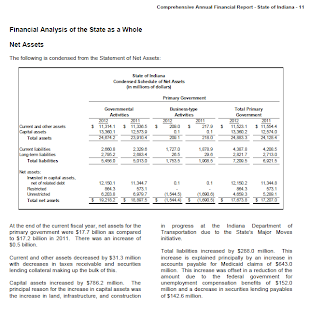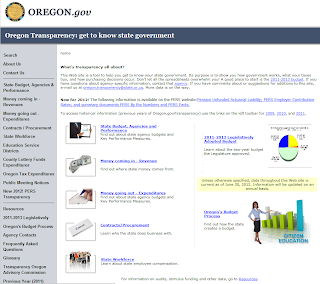Each region of the world has prepared for and began using
XBRL in one way or another. Some areas have
created “projects” to track their XBRL progress. The XBRL International has a great source for
finding these various projects at http://www.xbrl.org/knowledge_centre/projects/map. There are approximately 130+ projects around
the world in various stages from prototype to development to pilot to
implemented. According to the projects
list and map maintained by XBRL International, the majority of the projects are
located in Europe (~32 projects) and a mere 15 projects in the United States,
mostly on the east coast. The map allows
you to scan the globe and receive quick information of each project. You can also use the map’s information
bubbles to look into each project with more detail.
The two projects that I want to focus on today are the EBA
XBRL Project and the Oregon CAFR Project.
We’re going to look at how XBRL is being used by each project. We’ll learn what tools we would need to
implement our own XBRL project.
EBA stands for the European Banking Authority. They have joined efforts with the European
Insurance and Occupational Pensions Authority (EIOPA) to form the Eurofiling
project. They have collaborated with
XBRL Europe, stakeholders, schools, and individuals. The group is comprised of volunteers, regardless
of their affiliations. According to
their website, Eurofiling welcomes “employees of any supervisor, reporting
entity or XBRL industry/organization, as well as academics or any other
interested people” (Eurofiling Initiative, 2013).
In 2005, the Committee of European Banking Supervisors
created COREP (Common Reporting) “to achieve a common solvency ratio reporting
framework for credit institutions and investment firms under the EU capital
requirements regime” (Eurofiling Initiative, 2013). The COREP taxonomy was published in March 2006
and in late 2006 FINREP (Financial Reporting), the code-named reporting for
IAS/IFRS, and COREP projects were implemented (Eurofiling Initiative, 2013). The Eurofiling Initiative is responsible for
getting the whole region using the same standards for reporting.
Comprehensive Annual Financial Report (CAFR) was created by
the State of Oregon to promote transparency and innovation. The state is not required to report using
XBRL at this time; however, they took the initiative to get on board and lead
the pack of governmental units. It was
created by the Department of Administrative, it is audited by the Secretary of
State Audits Division, and it is published for the Governor and citizens of the
State of Oregon and for public consumption.
The goal was “to build an XBRL taxonomy for government accounting
standards used by state and local governments for financial reporting and then
express the state’s CAFR using XBRL” (Hoffman & Watson, 2010). In 2010, there were about 88,000 state and
local government units using it (Hoffman & Watson, 2010).
The Oregon State Controller, John Radford, was quoted saying
the following when considering the need for XBRL:
“Our XBRL investments in an
efficient global marketplace today will help sow the seeds for lower interest
cost tomorrow. For government financial
statement preparers, the marginal cost to convert existing financial reports in
XBRL will increase market efficiency and that’s a good thing. Our experience in Oregon is that the actual
cost is slightly more than converting existing files from spreadsheets and word
processors to XBRL. As market players
convert to XBRL, state and local governments should be ready.”
§
Identify instance/taxonomy versions and other
properties
§
Ensure
XBRL Tagging is
accurate and consistent with raw data and rendered data
§
Export to Excel, HTML, or listing of full
facts “working papers”
§
Analyze
extensions used
in the specific company taxonomy
§
Quick-search the standard taxonomy elements for
possible recommendations
§
Filter
and sort all
XBRL facts in a specific filing to pinpoint what’s most important to the review
§
Assure
the note tagging
granularity is at the proper level
§
Verify the labels and label linkbase match
the source
§
View the calculation hierarchy and
automatically check summations in the calculation linkbase
§
Compare all presentation links and line item
text via the rendered view, reviewer view, or data grid view
After this week’s research and after getting a better
understand of XBRL and how it can make our lives more efficient…I’m thinking
that an XBRL project at my employer may be around the corner for me!
References
Abraham,
C., & Kull, J. (2008, November 19). AGA research study predicts bright
future for XBRL use in state and local governments. accountingWEB.
Retrieved from
http://www.accountingweb.com/topic/aga-research-study-predicts-bright-future-xbrl-use-state-and-local-governments
admin.
(2011, November 14). List of free XBRL tools. FinanceSheets.com,
Retrieved from http://www.financesheets.com/list-of-free-xbrl-tool/
Beers,
A. & Savage, M. (2010, January 7). The sec mandated xbrl. Corporate
Finance Insider, Retrieved from
http://www.cpa2biz.com/Content/media/PRODUCER_CONTENT/Newsletters/Articles_2010/CorpFin/SEC_XBRL.jsp
European
Banking Authority, EIOPA, & XBRL Europe (2013). About us. Retrieved
from http://www.eurofiling.info/about_us/about_us.shtml
Hoffman,
C., & Watson, L. (2010). XBRL For Dummies. Indianapolis, IN: Wiley
Publishing, Inc.
Mueller,
D. (2009, June 25). Public Sector Case Study: State of Oregon CAFR Project.
Retrieved from
http://archive.xbrl.org/19th/sites/19thconference.xbrl.org/files/Microsoft
PowerPoint - JustSystems Mueller XBRL
Ramin,
K. & Reiman, C. (2013). IFRS and XBRL: How to improve Business Reporting
through Technology and Object Tracking. John Wiley & Sons, Ltd.
Rivet
Software. (2013). Dragon View. Retrieved from
http://rivetsoftware.com/solutions/quality-control/dragonview/
State of Indiana.
(2012). 2012 CAFR. Retrieved from http://www.in.gov/auditor/2530.htm
State of Oregon.
(2012). Oregon Transparency: get to know state government. Retrieved
from http://www.oregon.gov/transparency/Pages/index.aspx
XBRL
Espana. (2011, August 14). CEBS Why is XBRL recommended to be used? Retrieved
from
http://www.xbrlwiki.info/index.php?title=CEBS_Why_is_XBRL_recommended_to_be_used?
XBRL
International. (2013). XBRL Projects [demographic map]. Retrieved from
http://www.xbrl.org/knowledge_centre/projects/map
XBRL
International. (2013). EBA XBRL Project. Retrieved from
http://www.xbrl.org/project/eba-xbrl-project
XBRL
International. (2013). XBRL and Public Sector Financial Reporting: Oregon CAFR
Project. Retrieved from http://www.xbrl.org/project/xbrl-and-public-sector-financial-reporting-oregon-cafr-project




